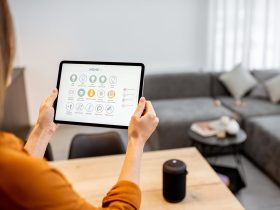You’re reading this online, and it’s probably all thanks to your (or somebody else’s) internet service provider. Let’s focus on what exactly these ISPs are, how they work, and the various types of services they offer. Can they see everything you do online? A VPN like Avira Phantom VPN is essential in helping you connect more securely and privately so you’re more invisible from prying eyes when you’re online. It’s not a magic bullet though, so always surf safely and practise good online habits (like never clicking on unknown links).
What is an internet service provider?
An internet service provider (ISP for short) is an organisation that connects people to the internet, whether they’re private or business users. The name says it all really: It’s a gateway to the world wide web that allows our web-enabled devices to access the online services and opportunities we take for granted. No ISP, no internet access (and no emails). Simples. What’s slightly more complicated, is that ISPs can provide these connections through different ways, including dial-up, DSL, cable, wireless, and fibre-optic connections.
There’s no single, ideal “type” of ISP either—in fact, many different companies can work as ISPs. These could be telephone companies, mobile carriers, cable providers… and they can be commercial, non-profit, privately owned or community-owned. With so many to choose from, it’s important that your ISP is just right for your needs. While we all cherish a fast, reliable connection, there are other factors to consider, like bandwidth capacity, location, and cost. But let’s start at the beginning and celebrate how far the internet has come.
From dial-up to DSL and beyond: A brief history of ISPs and how they connect us
Did you know that internet service providers have been around since the late 1960s? At that time the internet was a collaborative platform for researchers, academics, and government officials only (no dancing cats). The first ISP to offer affordable services to the general public was The World. Its first customer logged on in 1989, ushering in a new era of technology services. ISPs then started popping up worldwide and have been evolving rapidly ever since.
Join us for a whirlwind tour down internet memory lane, as we explore the different types of technologies offered by ISPs, and when they first made their appearance (in the UK, as an example).
Dial-up internet, 1990s: We’ve come a long way since the days of the shrill, annoying beeps that were the theme tune of dial-up internet access. Users had to connect their computer to a phone line and then a modem to connect to the internet, which meant they couldn’t use the phone and go online at the same time. Data crawled at just 56 kbps, and connections were often unreliable. It’s easy to sneer at dial-up connections now, but let’s show some respect. They did represent a giant leap from snail mail to email and offered the first widespread access to basic web browsing.
DSL, late 1990s: Digital Subscriber Line (DSL) was equally keen to take advantage of phone cables because they tend to be conveniently present in homes anyway. DSL offers two big advantages over dial-up: It uses higher telephone voice frequencies to provide much faster speeds (around 100 times faster than dial-up!) and users can make phone calls and go online simultaneously.
Cable, 2000: Cable TV companies generally offer broadband cable services and data is transmitted over copper TV lines. It’s generally considered faster and carries more bandwidth than DSL.
Both cable and DSL ushered in a new era of broadband internet and changed the game—literally. Thanks to much faster speeds, users could now play games online, stream media, and download larger files. The internet was becoming the playground of entertainment, e-commerce, and connectivity we know today. A host of familiar faces also burst onto the scene: Wikipedia in 2001. Facebook in 2004 and YouTube in 2005. These broadband networks would eventually pave the way for cloud computing, video conferencing, and the Internet of Things (IoT).
Fibre-optic broadband, 2008: In a flurry of fibre cables, the old copper lines were replaced and information was transmitted via pulses of light. Speeds leapt to 50Mbps (thank you Virgin Media, an early adopter). Before you get too excited, fibre-optic broadband is still ‘fibre-to-the-cabinet’ (FTTC), which means that these cables transmit information to a local cabinet (basically, an internet box), usually somewhere in your street. From there, traditional copper wires carry the signal to your home. This copper-based leg of the journey slows speeds down, especially at peak times. FTTC connections are also vulnerable to adverse weather, temperature fluctuations, and electromagnetic interference.
Full-fibre broadband, 2011: Finally, we were fully freed from the cumbersome cables that ran from street cabinets to our homes. For the first time, there were ‘fibre-to-premises’ connections. These plugged fibre-optic cables straight into our homes and speeds finally reached over 1000Mbps (1Gbps). Hold onto your hat! The UK government aims to have gigabit broadband available to 85% of the UK by 2025 and nationwide by 2030.
The internet also left houses and workplaces to leap into our pockets.
Mobile internet, 1991: Mobile phones with the power to tap into second-generation (2G) internet technology appeared and gave us gifts of SMS and MMS. But it was the 3G era that created the smartphone as we know it, with exciting new functionality like internet access, email, GPS tracking, and multimedia streaming—on a phone! Mobile apps sprung up, changing how we worked, shopped, and even travelled. Then came 4G, which enabled exciting new user experiences, like stunning HD streaming and remote collaboration services. 4G has two stand-out features: Long-Term Evolution (LTE) technology and Internet Protocol (IP) architecture, which allow for speeds up to 100 Mbps with low latency.
Have we reached peak internet—and will we ever? Probably not. 5G was first rolled out in South Korea in 2019 but has yet to go mainstream globally. It far surpasses its plodding predecessors in terms of capacity, reliability, and above all, speed. And we do mean it’s fast. With 5G, the average mobile phone user can expect theoretical maximum speeds of between 10 and 50Gbps—that’s at least 100 times faster than 4G!
The Internet hasn’t just got quicker; it’s headed into space.
Satellite broadband, 2003: The launch of Sputnik 1 in 1957 catapulted our dreams of data transmission into space but we had to be patient. The first internet-ready satellite for consumers was only launched in September 2003 but it was Elon Musk’s ambitious Starlink that changed the game quite recently. It deployed more satellites at a far lower orbit and aims to improve the speed and stability of satellite internet communications.
Back on earth, we’re working from home more than ever and consuming ever-growing volumes of data. ISPs need to provide connections that can handle truly heavy tasks, so it’s worth asking: Is yours up to the job, even if the future brings more smart home devices, online virtual reality experiences, and 8K picture quality?
How to choose an internet package: A checklist of top priorities
As you’ll have realised, without an ISP you can’t connect to the internet in your home or business, unless you’re prepared to use a mobile data plan and hotspot. A mobile data plan can give you fast, reliable internet—although a data cap can be an issue with some plans, and speeds will generally be slower. ISPs offer a variety of plans, so pick one that suits your needs and take advantage of discounts and promotions. In most countries, ISPs are also regulated by the government, so you’re assured a certain level of service.
Many ISPs often offer additional services, like email, web hosting, domain registration, and browser and software packages. Put together the digital buffet that suits your needs and budget, and consider what your priorities are:
- Speed? If you often stream videos and play high-end games, you’ll need a faster connection than someone who only tends to browse the web and check email. If you work from home and regularly send large files, you’ll also appreciate fast upload speeds and data transfers.
- Budget? The cost of your ISP plan varies depending on the speed and data allowance. If you’re a streaming addict, you’ll need a faster connection and all-you-can-eat data plans, but these come at a price. Beware of data caps as you’ll be charged for consuming more than your data ‘diet’ allows.
- Location? Are you reading this in the Namib Desert? Depending on your location, you may only have a few choices of local ISPs.
Let’s say you live in a household of four people, and three of you regularly stream 4K videos simultaneously. Then consider choosing a 100 Mbps package from your ISP. Always remember that there are many factors that influence internet speed, including where you place your Wi-Fi router, silent software updates, and how thick your walls are!
If you’re curious about how other people are likely to go online, browse statista.com to see internet accesses by type in many countries, such as the UK.
Which type of ISP provider is right for you?
Now that you’re familiar with the services offered by different ISPs and your key considerations, it’s time to pick a connection that suits you. We’ve started with the three lowest cost and lowest speed options.
- Dial-up services have been largely abandoned. Dial-up is considered secure and cost-efficient, but simply too slow. Recommended for: Those in very rural areas with no broadband availability. If you can afford it, choose satellite instead.
- DSL providers often offer a good compromise on speed and cost but are slowly becoming obsolete. If you choose DSL, make sure you live close to the provider, as distance affects speed. At least it’s not shared among other users so speeds shouldn’t decline during peak times. Recommended for: Rural users with few options and those on a tight budget.
- Broadband cable providers generally offer cable TV and internet services. You’ll usually experience low latencies and fewer lag times than DSL when browsing or playing online games. Beware that bandwidth is distributed between all users, so internet speeds will slow down if many people are online. Recommended for: Those looking to save money by bundling services, such as internet and cable TV.
- Fibre internet providers typically offer the maximum speed and lowest latencies, so you can expect fewer delays when gaming or video conferencing. New advancements are being made, such as establishing connections between countries via fibre optics running along the ocean bed. Recommended for: Those who value consistent, high speeds and high bandwidth capabilities. Ideal if you work from home or enjoy gaming, video editing, and streaming.
- Satellite internet providers often struggle to overcome the roughly 22.000 miles that data needs to travel from space to Earth, causing delays. Speed can also be affected by poor weather and network congestion. Recommended for: Those in very isolated or mountainous areas that want faster speed than dial-up or mobile internet.
- Web-hosting companies can act as ISPs to provide services like web hosting, online storage, cloud solutions, virtual servers, and more. Recommended for: Businesses that need exceptional performance, scalability, and flexibility.
How do ISPs work and what are ISP tiers?
Internet service providers are categorised into tiers based on the type of services they offer and the scope of their network. Know your ISP’s tier and you’ll understand more about them.
- Tier 1
These providers own (or control) their portion of the internet and tend to be more reliable than other tiers. Due to their vast infrastructure and resources, they can offer global connectivity. E.g.: Verizon, GTT, and Deutsche Telecom
- Tier 2
These companies lease bandwidth from Tier 1 ISPs and may also peer with other Tier 2 ISPs. They’re typically regional or national providers and may have slower access speeds than Tier 1 ISPs. E.g.: British Telecom, Virgin Media, and Vodafone
- Tier 3
These ISPs are primarily focused on providing internet access to end users, and they’re usually local with more limited coverage. They purchase or lease IP services from other tiers via one or more of the following relationships:
- Peering: Network owners give each other access to their customer routes.
- Transit: One network pays another network for internet access.
- Customer: One network pays another network for internet access and then provides it in return.
Your screen serves as a simple window to the online world, but behind it lies a tangled web of connections. Think of a giant virtual bazaar, with local ISPs selling access to their customers and paying larger ISPs for their own access… and so on, until this trail leads all the way to Tier 1 carriers.
ISPs and privacy: What do they know about you?
Do you enjoy watching videos of dancing dogs? Your ISP might know. It also knows how much time you spend watching these videos, what search terms you used to find them, and which apps you’ve downloaded. And if you’re watching dancing dogs from your flat in London, England, it knows that too (even if your location services are off) thanks to your computer’s unique IP address. In theory, ISPs can “see” what we do online, so they’re in a position to gather a wealth of information about us and even share this data with third parties like advertisers. To find out more, see our comprehensive guide on web tracking and how to stop it.
ISPs can also decide what websites you’re allowed to visit. Although they usually don’t care, some governments may use these powers to curb the online freedoms of their citizens. Did you know that in the EU, almost all member states previously required ISPs to log their customers’ browsing activities and keep the logs for at least 12 months (as per the 2006 Data Retention Directive)? Although this was later repealed, EU laws around customer data require ISPs to retain certain information (like websites visited, URLs, time spent, and bandwidth) for a certain period of time for legitimate reasons.
Most websites nowadays are encrypted HTTPS sites, which means that they use the SSL/TLS protocol to encrypt communications. This helps make them more trustworthy and secure, so you’re less vulnerable to eavesdropping. Don’t forget: ISPs will still know which websites you visited and make assumptions based on that. So if you want to further increase your privacy online, a virtual private network (VPN) is a more effective option.
Help protect yourself from ISP snooping with Avira Phantom VPN
A VPN, like Avira Phantom VPN, has several powerful ways of helping to shield your data traffic and activities online: It encrypts your data and passes it through a secure tunnel between your device and one of its many remote VPN servers. It also masks your real IP address, so others won’t be able to track you or know your location—so your online activities can’t be tied back to you. In addition to Windows, Avira Phantom VPN is also available for Mac, Android, and iOS.














